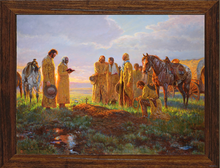
Note: All unframed prints will come rolled in a tube. Please inquire at clarkkelleyprice@gmail.com if you would like your canvas print mounted or gallery wrapped. Framed paper prints come with matting on the edges. Framed canvas prints will have no matting.
About this Art:
Not long after the Civil War the market for beef expanded rapidly in the Eastern states and the Midwest. Getting the beef to those markets presented a logistical challenge with so few railheads where the cattle could be loaded on trains for the long journey eastward to Chicago and other beef processing establishments. The majority of the cattle herds were located many, many hundreds of miles distant from the railheads, mainly in Texas. It would require men who were willing to face the dangers and the loneliness of the trail to get those cattle to those railheads for shipment eastward. These men would be required to sleep on the ground every night and herd the cattle by day for months at a time to move those big herds of cattle to the railheads, such as Dodge City, Kansas. These men became known as cowboys. Most of them were teenagers and in their 20's or early 30's. The pay was low - usually around $40 a month.
The work was long, hard, and dangerous. They were in the saddle most of the day, everyday. They had to swim their horses and the cattle across swollen rivers. The currents were strong and many horses, cowboys and cattle drowned in these dangerous crossings. Other cowboys and horses were killed in stampedes. Usually at night time the cattle could be frightened off the bed ground by lightning, thunder, wind, strange noises, Native Americans, etc. Once they were frightened they broke into a run not knowing where they were going. The cowboys had to jump from their beds, quickly saddle their horses, then ride at full speed in the darkness trying to get ahead of the leaders and turn the herd into a circular direction so that eventually the herd would move against itself (called milling) and finally come to a stop. There were dangerous badger holes, prairie dog holes, and if their horses tripped and fell down sometimes the cowboys were trampled to death by the running cattle.
The early light of morning was the time when the missing cowboys were found, graves were dug, and they were buried on the Lone Prairie. Sometimes the Bible was read from, maybe a short eulogy was given or a hymn was sung, and the cowboys mounted up with swollen, broken hearts and tear stained cheeks, leaving their friend on the prairie where he died and ready to move the cattle onward to their destination. A cowboy never really knew from one day to the next what might happen to him in that dangerous occupation and many used the time to draw closer to God.







